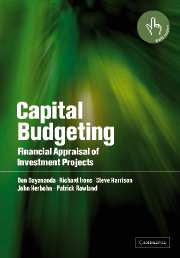Book contents
- Frontmatter
- Contents
- List of figures
- List of tables
- Preface
- 1 Capital budgeting: an overview
- 2 Project cash flows
- 3 Forecasting cash flows: quantitative techniques and routes
- 4 Forecasting cash flows: qualitative or judgemental techniques
- 5 Essential formulae in project appraisal
- 6 Project analysis under certainty
- 7 Project analysis under risk
- 8 Sensitivity and break-even analysis
- 9 Simulation concepts and methods
- 10 Case study in financial modelling and simulation of a forestry investment
- 11 Resource constraints and linear programming
- 12 More advanced linear programming concepts and methods
- 13 Financial modelling case study in forestry project evaluation
- 14 Property investment analysis
- 15 Forecasting and analysing risks in property investments
- 16 Multinational corporations and international project appraisal
- References
- Index
12 - More advanced linear programming concepts and methods
Published online by Cambridge University Press: 14 May 2010
- Frontmatter
- Contents
- List of figures
- List of tables
- Preface
- 1 Capital budgeting: an overview
- 2 Project cash flows
- 3 Forecasting cash flows: quantitative techniques and routes
- 4 Forecasting cash flows: qualitative or judgemental techniques
- 5 Essential formulae in project appraisal
- 6 Project analysis under certainty
- 7 Project analysis under risk
- 8 Sensitivity and break-even analysis
- 9 Simulation concepts and methods
- 10 Case study in financial modelling and simulation of a forestry investment
- 11 Resource constraints and linear programming
- 12 More advanced linear programming concepts and methods
- 13 Financial modelling case study in forestry project evaluation
- 14 Property investment analysis
- 15 Forecasting and analysing risks in property investments
- 16 Multinational corporations and international project appraisal
- References
- Index
Summary
Selecting a portfolio of investment projects from a larger group of potential projects is a common decision problem in capital budgeting. The basic concepts and applications of linear programming were introduced with reference to simple resource allocation and capital budgeting problems in Chapter 11. This chapter explores further the application of linear programming (LP) to capital budgeting, and demonstrates the power and versatility of the technique.
Recall from Chapter 11 that linear programming requires that the decision problem be represented within a mathematical framework of optimizing a linear objective function of activity levels subject to a set of linear constraints. In this context, the investment projects become activities, the levels of which are restricted by limited capital and other resource constraints. The objective function represents the total payoff from the investment portfolio, typically in terms of net present value. LP problems are invariably solved using a computer package.
A number of restrictive assumptions were made in the examples in Chapter 11 so that they would conform to the LP framework. The current chapter first reviews the nature of these assumptions, and the limitations they impose on the formulation of capital budgeting problems. Various model formulation approaches to overcome these limitations are then explained, and examples presented in the form of LP tableaux. The specific extensions presented include: expanding the model for greater numbers of activities and constraints; modelling indivisible investments; allowing for borrowing and transferring resources between years; representing interdependent projects; specifying investments as mutually exclusive; and dealing with threshold investment levels, economies of scale, multiple goals and investment risk.
- Type
- Chapter
- Information
- Capital BudgetingFinancial Appraisal of Investment Projects, pp. 219 - 235Publisher: Cambridge University PressPrint publication year: 2002



